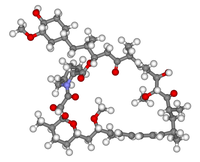
Hyperglycemia‐induced hyponatremia: Reevaluation of the Na+ correction factor
Sign Up to like & getrecommendations! Published in 2017 at "Journal of Critical Care"
DOI: 10.1016/j.jcrc.2017.06.025
Abstract: ABSTRACT This study addresses the clinically important relationship between the decreases in plasma Na+ and the increases in plasma glucose concentrations seen in diabetes and other hyperglycemic syndromes. This plasma ‘Na+ correction factor’, is generally… read more here.
Keywords: induced hyponatremia; correction; glucose concentrations; correction factor ... See more keywords

Amelioration of hyperglycemia-induced oxidative damage in ARPE-19 cells by myricetin derivatives isolated from Syzygium malaccense
Sign Up to like & getrecommendations! Published in 2020 at "Journal of Functional Foods"
DOI: 10.1016/j.jff.2020.103844
Abstract: Abstract Myricetin derivatives (F2) isolated from leaf extract of Syzygium malaccense (Malay apple) which contains myricitrin predominantly, could potentially serve as functional food ingredient based on previous findings. The present study aimed to investigate the… read more here.
Keywords: arpe cells; derivatives isolated; myricetin derivatives; induced oxidative ... See more keywords

PARP1 deficiency protects against hyperglycemia-induced neointimal hyperplasia by upregulating TFPI2 activity in diabetic mice
Sign Up to like & getrecommendations! Published in 2021 at "Redox Biology"
DOI: 10.1016/j.redox.2021.102084
Abstract: Diabetes mellitus (DM) promotes neointimal hyperplasia, characterized by dysregulated proliferation and accumulation of vascular smooth muscle cells (VSMCs), leading to occlusive disorders, such as atherosclerosis and stenosis. Poly (ADP-ribose) polymerase 1 (PARP1), reported as a… read more here.
Keywords: induced neointimal; proliferation; hyperglycemia induced; parp1 ... See more keywords

Hyperglycemia-induced VEGF and ROS production in retinal cells is inhibited by the mTOR inhibitor, rapamycin
Sign Up to like & getrecommendations! Published in 2021 at "Scientific Reports"
DOI: 10.1038/s41598-021-81482-3
Abstract: Determine the impact of the mTOR inhibitor, rapamycin, on the hyperglycemia-induced expression of vascular endothelial growth factor (VEGF) and the production of reactive oxygen species (ROS) in retinal cells. Rats made hyperglycemic for 8 weeks… read more here.
Keywords: inhibitor rapamycin; mtor inhibitor; hyperglycemia induced; induced vegf ... See more keywords

Hyperglycemia-induced TET3 insufficiency is responsible for maternal transmission of glucose intolerance
Sign Up to like & getrecommendations! Published in 2022 at "Biology of Reproduction"
DOI: 10.1093/biolre/ioac115
Abstract: Hyperglycemia-induced TET3 insufficiency is responsible for maternal transmission of glucose intolerance† Wei Yan1,2,* and Marisa S. Bartolomei3,* 1The Lundquist Institute for Biomedical Innovation at Harbor-UCLA Medical Center, Torrance, CA, USA 2Department of Medicine, David Geffen… read more here.
Keywords: hyperglycemia induced; insufficiency responsible; tet3 insufficiency; induced tet3 ... See more keywords

Trans-ferulic acid attenuates hyperglycemia-induced oxidative stress and modulates glucose metabolism by activating AMPK signaling pathway in vitro.
Sign Up to like & getrecommendations! Published in 2022 at "Journal of food biochemistry"
DOI: 10.1111/jfbc.14038
Abstract: Adenosine monophosphate-activated protein kinase (AMPK) is a potent metabolic regulator and an attractive target for antidiabetic activators. Here we report for the first that, trans-ferulic acid (TFA) is a potent dietary bioactive molecule of hydroxycinnamic… read more here.
Keywords: hyperglycemia induced; trans ferulic; hyperglycemia; pathway ... See more keywords

Hyperglycemia‐induced ubiquitination and degradation of β‐catenin with the loss of platelet endothelial cell adhesion molecule‐1 in retinal endothelial cells
Sign Up to like & getrecommendations! Published in 2019 at "Microcirculation"
DOI: 10.1111/micc.12596
Abstract: Increased retinal vascular permeability is one of the earliest manifestations of diabetic retinopathy. The aim of this study was to investigate the role of hyperglycemia‐induced platelet endothelial cell adhesion molecule‐1 loss on retinal vascular permeability… read more here.
Keywords: endothelial cell; cell adhesion; adhesion molecule; hyperglycemia induced ... See more keywords

Geniposide Attenuates Hyperglycemia-Induced Oxidative Stress and Inflammation by Activating the Nrf2 Signaling Pathway in Experimental Diabetic Retinopathy
Sign Up to like & getrecommendations! Published in 2021 at "Oxidative Medicine and Cellular Longevity"
DOI: 10.1155/2021/9247947
Abstract: Geniposide (GEN) is a natural antioxidant and anti-inflammatory product and plays an important role in the treatment of diabetes and diabetic complications. To explore the biological functions and mechanism of GEN in diabetic retinopathy (DR),… read more here.
Keywords: hyperglycemia induced; induced oxidative; oxidative stress; diabetic retinopathy ... See more keywords

Aldose Reductase Mediates NLRP3 Inflammasome‐Initiated Innate Immune Response in Hyperglycemia‐Induced Thp1 Monocytes and Male Mice
Sign Up to like & getrecommendations! Published in 2017 at "Endocrinology"
DOI: 10.1210/en.2017-00294
Abstract: &NA; Despite recent studies that show oxidative stress‐generated reactive oxygen species (ROS) regulate NOD‐like receptor family pyrin domain containing 3 (NLRP3) inflammasome‐mediated innate immune response in various diabetic complications, the mechanism by which ROS activate… read more here.
Keywords: thp1 monocytes; hyperglycemia induced; immune response; nlrp3 inflammasome ... See more keywords

C-peptide attenuates hyperglycemia-induced pulmonary fibrosis by inhibiting transglutaminase 2.
Sign Up to like & getrecommendations! Published in 2022 at "Journal of molecular endocrinology"
DOI: 10.1530/jme-21-0271
Abstract: Proinsulin C-peptide has a protective effect against diabetic complications; however, its role in hyperglycemia-induced pulmonary fibrosis is unknown. In this study, we investigated the inhibitory effect of C-peptide on hyperglycemia-induced pulmonary fibrosis and the molecular… read more here.
Keywords: hyperglycemia; pulmonary fibrosis; peptide; hyperglycemia induced ... See more keywords

KDM3A Inhibition Ameliorates Hyperglycemia-Mediated Myocardial Injury by Epigenetic Modulation of Nuclear Factor Kappa-B/P65
Sign Up to like & getrecommendations! Published in 2022 at "Frontiers in Cardiovascular Medicine"
DOI: 10.3389/fcvm.2022.870999
Abstract: Objectives Even after the glucose level returns to normal, hyperglycemia-induced cardiac dysfunction as well as reactive oxygen species (ROS) generation, inflammatory responses, and apoptosis continued deterioration, showing a long-lasting adverse effect on cardiac function and… read more here.
Keywords: myocardial injury; hyperglycemia induced; p65; factor ... See more keywords